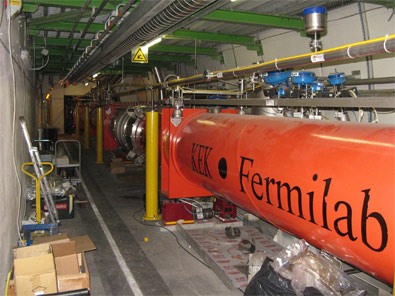Steering a high-intensity beam
Much of the LHC upgrade work is still at the proposal stage, but two projects have already been approved. In 2008 work began on Linac4, part of the new injector chain to create higher intensity proton beams for the LHC. The other approved project is the “LHC Interaction Region Upgrade – Phase-1”, which will increase the focus of the beams within the LHC itself.
Over 1200 dipole magnets steer the two LHC beams around the circular beam pipes, and almost 400 quadrupole magnets keep both beams focussed. Twenty-four of those magnets, called the “inner triplets”, help to tightly focus the proton beams just before they enter the detectors. It’s the inner triplets and the associated “separation dipole” magnets around the two largest LHC detectors – ATLAS and CMS – that are of particular interest to the LHC Interaction Region Upgrade team.
Squeeze the beam
The inner triplets act a bit like magnifying glasses. As the proton beams enter one of the LHC detectors from either side, the inner triplets focus each beam to a fine spot in the centre of the detector. It’s here that the two beams collide and generate a shower of exotic particles. The number of new particles produced is defined by the luminosity of the LHC, itself directly proportional to the beam size in the detectors.
In 2014, when work on LHC IR Upgrade Phase-1 is complete, the plan is to ramp up the luminosity of the LHC by three times. This requires smaller beam spots in the detectors and will require stronger magnifying glasses. The redesigned inner triplets will help the physicists to get the most from the upgraded LHC.
“We plan to use a wider aperture,” says Stephan Russenschuck at CERN. “The wider the aperture of the inner triplets the smaller the beam size.” To really squeeze the two beams together at the interaction point and increase the number of collisions, those wider apertures are a must.
In recent years, with funding from the CERN’s New Initiatives programme and SLHC-PP, the LHC Interaction Region Upgrade team has worked out the exact requirements of the new inner triplets. The magnets and other required equipment should be built and ready for use by 2014.
Radiation rise
But improving the focusing of the magnets is only half the story. When the two beams collide in the detectors new particles and electromagnetic radiation is released, which oozes out of the detectors themselves and into the nearby LHC tunnels, where it can raise the temperature of the inner triplets and the separation dipoles and irradiate equipment.
That’s bad news because the magnets are designed to be most effective at incredibly low temperatures – they are cooled to 1.9 Kelvin or -271ºC. “The radiation brings heat into the magnets and increases the temperature and then the magnets simply don’t work,” says Ranko Ostojic at CERN. That’s an existing problem, so there are systems in place to remove the extra heat. But those systems aren’t designed to deal with the extra radiation that will accompany the luminosity upgrade in 2014.
“Right from the very first day after upgrade, we will need new heat exchangers inside the magnets to remove extra heat,” Ostojic says. As part of the LHC IR Upgrade, work is well underway to design and build these new systems.
LHC Interaction Region Upgrade – Phase-2
Russenschuck stresses that the new magnets for 2014 won’t be a radical departure from those already in use – indeed, they will be made using the superconducting cable left over when the existing magnets were built. “It’s quite proven technology,” he says.
But work is already underway for a second round of upgrades later in the next decade, to coincide with completion of the new LHC injector system – the Superconducting Proton Linac, Proton Synchrotron 2 and upgrade of Super Proton Synchrotron.
At that point, the LHC luminosity will be three times higher again – or ten times higher than with the beams that will race around the LHC this year. The magnets will need upgrading again to deal with these new conditions.
“There is no definite design of that second phase of LHC modifications yet,” says Ostojic. “It will certainly involve inner triplets again, but it will probably affect other systems too. We’re fairly sure what the limits are for Phase 1 of the upgrade, but for Phase-2 things are more difficult. Right now, we’re doing research and development on several critical systems. We also need the experience of running the LHC with first beams.”
One of the Fermilab-built quadrupole magnets, used to direct the proton beams





